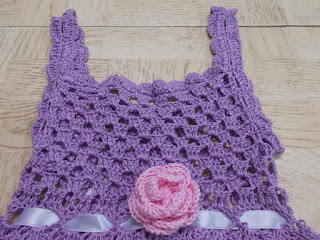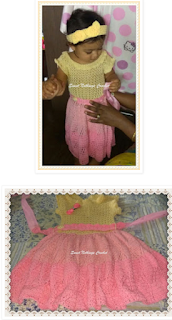Size made : Chest : 20” ; Length 18.5”
You can make this to any size. Size just given for yarn estimation reference.
Difficulty level : Intermediate to advanced level
Stitches used : Using U.S terminology
Here is a sizing chart for general neck sizing here or here
Here is a sizing chart for general body sizing here , here or here
Abbreviations used :
ch : Chain sp(s) : Space(s)
dc : Double crochet hk : Hook
st(s) : Stitch(es) sl-st : slip stitch
sk : Skip sp : space
rep : repeat
fsc : Foundation single crochet
Instructions
Please note that I start all my rows with a ch 1, turning chain for ease.
Please check the top of this blog for easy video tutorials on all stitches used in today's pattern.
Please read through all my notes before you pick up your hook, so you know just where we're heading in our pattern.
In my patterns I work with the principle of stitch count and body measurement.
This means that you need to work the stitch count in pattern, till you get the measurement (length and/or width) that you need for your project.
Inspired by the charts (but no written pattern) at this link here are my notes as I make my project
So before we set off on our new creative journey, let’s take a quick look at what we’re creating here today.
There are four parts to our shelled dress project today.
We start with the yoke, and work from the waist up to the shoulder, and then we come back down to this start row and work down for the skirt.
Now the yoke is worked in one piece, and we work back and forth so that we work a 4 dc placket at the back for closure.
We then come back to the start fsc row and work the skirt from this row, in rounds.
The top of our yoke is a straight line (so no decreases and worries) and there’s a neat scalloped strap for the shoulders.
For the final bit, we will make a cute rose to embellish this already cute dress. so let’s get started.
Now the big question.. how do you calculate how many stitches to start?
Well, for this pattern, we’ve got it super easy – we just work the measure for the round waist – and working with the pattern repeat for the waist, you work that many fsc stitches for your start row.
For the button placket, do remember to add 4 sts to the start row count.
PART I : YOKE
Start with fsc in multiples of 5 + 4 (for placket). Turn
Double Crochet : dc : yo, insert hk into st ; yo (3 lps on hk);
[yo, draw through 2 lps] twice. One dc made.
Chainless start for Double Crochet : I dislike the ch-2 / ch – 3 start, and this is what I do to start my row of dc.
Row 1 : dc in the 1st 2 dc ;
*ch 2, sk next 2 fsc, dc in next 3 fsc* ;
rep from *to* till last 2 fsc ;
dc in last 2 fsc. Turn.
Row 2 : dc in the 1st 2 dc ;
2 dc in the ch-2 sp ;
*ch 2, sk next 3 dc ; 2 dc in the ch-2 sp*;
rep from *to* till last 2 dc ;
dc in last 2 dc. Turn.
Row 3 : dc in the 1st 2 dc ;
*ch 2, sk next 3 dc, 3 dc in the next ch-2 sp* ;
rep from *to* till last 2 dc ;
dc in last 2 dc. Turn.
Rep Rows 2 and 3 , ending with a Row 3 till you reach just under the armhole, and then we’ll do a quick decrease.
So the next question is how does one calculate how high to go with the yoke?
Well, I usually take the easy way out and use a well-fitting dress of the person for whom this is intended as a marker,
but the thumb rule is also that the yoke is just about 1/3rd of the whole dress length, for younger kids (i.e till Age 1).
For older kids, the yoke should come just under the armhole, so that the skirt portion of the dress starts just under the armhole.
And though this chart is not in English, with the above hint(s), you will get a better handle on all of this.. else, trial and error.. always the best teacher, I'd say.
Decrease Row : dc in the 1st 2 dc ;
2 dc in the ch-2 sp
*ch 2, sk next 3 dc ; 2 dc in the ch-2 sp*;
rep from *to* till the corner marker ;
sk the last 3 dc before the marker. Turn.
Rep Rows 3 and 2 till your project reaches the level you wish for the neckline.
The neckline in this dress will be a straight one – so pretty simple, right?
Remember that there is a small strap that we need to make.
Instructions for this after the skirt / body of dress.
PART 2 : BODY OF DRESS
So for this portion of the dress, we go back down to the first fsc row we’ve started with, and keeping the yoke of the dress facing you, we will work the skirt portion of the dress.
We work the body or skirt portion of the dress in rounds.
So remember to join with a sl-st at the end of the round.
When working with the lower skirt portion, you could either overlap the 4 dc border / placket (for older children) or you work in a loop along one edge and add the button on the other placket edge.
If overlapping, do remember that you need to do that before you work the bottom skirt bit (i.e overlap it and then work the stitches over both plackets.
The designer has used three colours for her skirt portion – each shell (two rounds of pattern) making one colour strip.
So while I will indicate where you need to change, you could do this beauty in one colour as well.
Our stitch count is in multiples of 6.
So for this portion, we’re going to run a row of ch-6’s (or ch-6 spaces) all around going through all the ch-2 sps of that first fsc row.
To start, let’s re-attach the yarn at the centre back of the dress – on the first fsc row.
Round 1 : *ch 6, sk next 3 dc, sc in the next ch-2 sp* ;
rep from *to* all around ;
and join with a sl-st to the 1st st.
Round 2 : sl-st into the 1st ch-6 sp ;
sc in the same 1st ch-6 sp ;
(ch 1, dc) in the same ch-6 sp ;
rep (to) 3 times ;
*dc in the next ch-6 sp ;
rep (to) 4 times* ;
rep from *to* all around ;
and join with a sl-st to the 1st st.
Round 3 : sl-st into the 1st ch-1 sp ; sc in the same ch-1 sp ;
(ch 3, sc in the next 1st ch-1 sp) ;
rep (to) 2 times ;
*sc in the next ch-1 sp ;
rep (to) 3 times* ;
rep from *to* all around ;
and join with a sl-st to the 1st st.
Note : If changing colours, change now.
Round 4 : sk the 1st ch-3 sp and sl-st into the next ch-3 sp ;
dc in the same ch-3 sp ;
(ch 1, dc) in the same ch-3 sp ;
rep (to) 3 times ;
*sk next two ch-3 sps , dc in the next ch-3 sp ;
rep (to) 4 times* ;
rep from *to* all around ;
and join with a sl-st to the 1st st.
Round 5 : sl-st into the 1st ch-1 sp ;
sc in the same ch-1 sp ;
(ch 3, sc in the next 1st ch-1 sp) ;
rep (to) 2 times ;
*sc in the next ch-1 sp ;
rep (to) 3 times* ;
rep from *to* all around ;
and join with a sl-st to the 1st st.
Rounds 4 and 5 form one pattern repeat.
If changing colours, change after Round 5 for each colour repeat.
Rep Rounds 4 and 5 till length needed.
Notes : So here are a few ideas
If using multiple colours, instead of changing every pattern repeat, you could change every second pattern repeat – so you have two pattern rounds in each colour.
Secondly, I am pretty happy with the ‘flared’ shape as I’m also making this dress for a younger child, but if you want more of a flared shape, you could add a few (ch 1, dc) repeats in Round 4 (and then you will have to similarly increase the repeats in Round 5) and add to the flare in the lower part of the dress.
Note that if you do decide to increase the (ch 1, dc) pattern repeat, it must be in ODD numbers.
In this pattern we have a total of 5 dcs and 4 ch-1 sps, so you will need to increase that to 7 dcs with 6 ch-1 sps etc.
Great .. so off we go and complete our lovely dress.
Once done, fasten off and weave in all ends.
Then let’s go and show off this new creation on all the social networking pages – remember to tag me and add the blog url when you share it on social media. Thanks.
Basically, I’m going to work a fsc row and then work scallops on both sides – so we work scallops on one side of fsc, then go around and work scallops around the other side and as we’re doing the scallops, we’ll do it all around the neckline and armhole.
Start with as many fsc as you want for the length of your shoulder strap
How do you measure this length? Place the dress on the child or on top of that well-fitted dress I’ve mentioned before and calculate length for strap.
Row 1 : sc in the 1st fsc ;
*ch 5, sk next 4 fsc, sc in the next fsc* ;
rep *to* till end. Turn.
Row 2 : sc in the 1st sc , 7 dc in the 1st ch-5 sp ;
*sc in the next sc ;
7 dc in the next ch-5 sp* ;
rep *to* till end.
Turn. Fasten off and weave in ends.
Re-attach yarn onto the other side of this same fsc chain and Rep Rows 1 and 2 for the scalloped finish on the other side.
Make two such straps and attach them onto the top of the yoke (front to back).
Fasten off and weave in ends, attach your button and a lovely satin ribbon .. and Voila ! Yet another beautiful dress made for your young lady.
Right then, let's start , shall we?
Start with a fsc in multiples of 3 + 1.
I started with 52 fsc.
Row 1 : dc in the 1st fsc ,
*sk next 2 fsc, [2 dc, ch 1, 2 dc] in the next fsc* ;
rep *to* till last fsc ;
dc in the last fsc. Turn.
Now for the next row, we’re going to make the frilly petal bits.
For this we will use the space between 2 sets of the “V” stitches.
Now this is not an actual space – but it is the ends of the 2 sts, and will hold the 8 dcs up like a fan.
Hopefully you’ve understood what I mean.. and will follow with the chart and photo below.






















































No comments:
Post a Comment
Thanks for taking the time to stop by. Do tell me what you think. Cheers